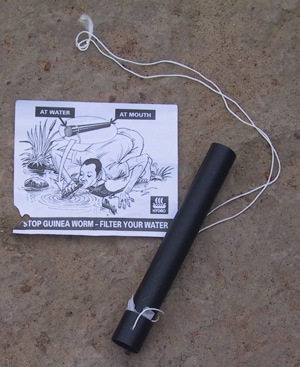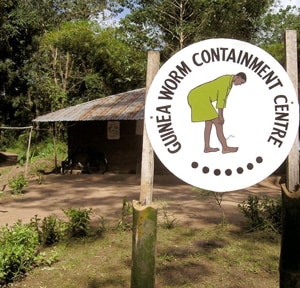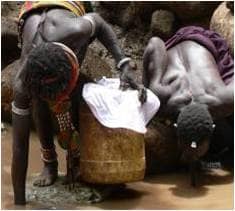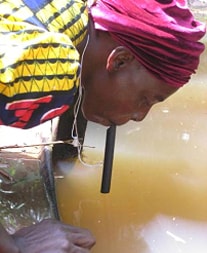Prevention & Control
Guinea Worm Eradication Program Interventions

Pipe filter in Sudan. Credit: WHO Collaborating Center for Dracunculiasis Eradication Archives/Sharon Roy, 2002
The Guinea Worm Eradication Program (GWEP) is a group of national and international partners whose purpose is to support the global eradication of Guinea worm disease (GWD). Prevention of GWD is based on the following:
- Surveillance (case detection) and case containment (preventing contamination of drinking water sources by infected persons or animals)
- Provision of safe drinking water
- Vector control (killing of the copepods involved in the Guinea worm life cycle) using the approved chemical temephos
- Health education and community mobilization.
Many of these interventions are provided by village volunteers—people who are selected by the community to work with the GWEP. Village volunteers are the backbone of the program. In their communities, they identify and manage people with GWD and prevent them from contaminating drinking water sources (case containment). They also distribute water filters and provide health education to the community.
Surveillance and Case Containment
GWEP village volunteers look daily for GWD cases in their communities. Every month they report the total number of cases detected in their communities to supervisors who compile this and send it to the national GWEP headquarters. This information is then shared with The Carter Center and the World Health Organization (WHO). The GWEP uses this information to identify where transmission is ongoing and to understand how the disease is spreading.

Case containment center in Nigeria. Credit: The Carter Center/Emily Staub, 2004
Case containment is one of the key methods used to prevent the spread of GWD. Case containment centers have been built in strategic locations in several countries[1]. These centers provide treatment and support to people with GWD and help prevent them from contaminating water sources. A case of GWD is considered to be contained if all of the following conditions are met[2, 3] .
- The person is identified before or within 24 hours of the worm emerging; AND
- The person has not entered any water source since the worm has emerged; AND
- A village volunteer or other health care provider has properly managed the case, by cleaning and bandaging the wound until the worm has been fully removed and by providing health education to discourage the patient from contaminating any water source (if two or more emerging worms are present, the case is not contained until the last worm is removed); AND
- Within seven days of the worm emerging, a GWEP supervisor determines that the above criteria have been met and the case is truly GWD; AND
- The approved chemical temephos (ABATE®*) is used to treat potentially contaminated surface water if there is any uncertainty about contamination of sources of drinking water or if a source of drinking water is known to have been contaminated and if the water body in question meets certain other logistical criteria.
The criteria for defining a contained case of Guinea worm disease in a human also should be applied, as appropriate, to define containment for an animal with a Guinea worm infection.
Safe Water

Guinea worm filter cloth. Credit: WHO Collaborating Center for Dracunculiasis Eradication Archives
Safe drinking water sources include bore-hole wells and deep hand-dug wells with protective walls around them that prevent contaminated water from flowing back into the well (e.g., after rains or floods or if someone pours/spills water nearby the well). Flowing water, such as that found in a stream or river, is also safe from Guinea worm. The GWEP advocates for the development and maintenance of safe drinking water sources. It also encourages treatment of potentially contaminated drinking water. Fine-mesh cloth filters are given to households to strain out copepods (tiny “water fleas” too small to be clearly seen without a magnifying glass) from contaminated drinking water where there are no safe water supplies. People who travel or work away from the household and might not have access to filtered water are given individual pipe filters. These devices are used like straws to drink water from unsafe water sources.
Vector Control
A vector is an organism that carries or transmits disease. The vector for GWD is the copepod. To control this vector, the GWEP puts a measured amount of the approved chemical temephos (ABATE®*) into the water sources that are suspected or known to be contaminated with Guinea worm-infected copepods. This chemical kills the infected copepods and prevents people from becoming infected with GWD when they drink the water.

Nigerian woman using a pipe filter to drink water directly from a pond. Credit: The Carter Center/Emily Staub, 2002
Health Education and Community Mobilization
Health education and community mobilization are important aspects of GWD eradication. Activities include the following:
- Teaching communities about the disease and how it is spread
- Educating people during household visits by GWEP volunteers and staff and through organized events, such as Worm Weeks
- Helping villagers take action against the disease
- Not entering water sources, like lakes and ponds, with emerging worms to prevent contaminating drinking water supplies
- Using water filters to protect against GWD
- Burying or burning fish guts left over from fish processing to prevent dogs from eating them, and avoiding feeding fish guts to dogs
- Thoroughly cooking any fish and other aquatic animals before eating them to prevent themselves from becoming infected
- Working in partnership with the GWEP to tether dogs known or suspected to be infected until their worms are fully emerged or infection is ruled out
- Helping villagers understand the need for safe chemical treatment (temephos) in their water supplies
*Use of trade names is for identification only and does not imply endorsement by the Public Health Service or by the U.S. Department of Health and Human Services.
References
- Hochberg N, Ruiz-Tiben E, Downs P, Fagan J, Maguire JH. The Role of Case Containment Centers in the Eradication of Dracunculiasis in Togo and Ghana. Am J Trop Med Hyg, 2008. 79(5): p. 722–8.
- WHO Collaborating Center for Dracunculiasis Eradication, Guinea Worm Wrap Up #194, 2010. Centers for Disease Control and Prevention (CGH): Atlanta. https://www.cartercenter.org/resources/pdfs/news/health_publications/guinea_worm/wrap-up/194.pdf
- Hopkins DR, et al., Progress Toward Global Eradication of Dracunculiasis, January 2016–June 2017. MMWR, 2017 Dec 8. 66(48): p. 1327–31. https://www.cdc.gov/mmwr/volumes/66/wr/mm6648a3.htm?s_cid=mm6648a3_w